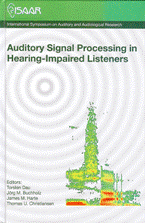Simultaneous multiple stimulation of the auditory steady-state response (ASSR)
Abstract
The present study evaluates some characteristics of the ASSR related to the use of multiple, simultaneous, band-limited chirp-stimuli. In a diagnostic study four one-octave-band chirp-stimuli (500, 1,000, 2,000 and 4,000 Hz) were used to measure the ASSR-threshold in 10 normal-hearing adults. The four stimuli were presented simultaneously to both ears (eight stimuli) with rates at about 90/s. The ASSRs were detected automatically (error rate 5%), and the thresholds evaluated with a resolution of 5 dB. The ASSR thresholds were compared to the audiometric thresholds for all 20 ears and the deviations evaluated by the group means and standard deviations. These data compare favorably well with similar data reported by others. In a screening study a low-frequency chirp, (Lo: 180 – 1,500 Hz) and a high-frequency chirp (Hi: 1,500 – 8,000 Hz), was used to record the ASSR in 72 newborns. The two stimuli were presented both sequentially and simultaneously using a rate at about 90/s and a level of 35 dBnHL. The ASSRs were detected automatically (error rate 0.1%), and evaluated by the detection time. The results from both studies demonstrate that simultaneous application of multiple, frequency-specific stimuli can effectively be applied without sacrificing response detection accuracy. However, in the screening study stimulus interactions were observed.
References
Dau, T., Wagner, O., Mellert, V., and Kollmeier, B. (2000). “Auditory brainstem responses with optimized chirp signals compensating basilar membrane dispersion,” J. Acoust. Soc. Am. 107(3), 1530-1540.
D’haenens, W., Dhooge, I., De Vel, E., Maes, L., Bockstael, A., and Vinck, B. M. (2007). “Auditory steady-state responses to MM and exponential envelope AM2/ FM stimuli in normal-hearing adults,” Int. J. Audiol. 46, 399-406.
Dimitrijevic, A., John, M. S., van Roon, P. S., Purcell, D. W., Adamonis, J., Ostroff, J., Nedzelski, J. M., and Picton, TW. (2002). “Estimating the audiogram using multiple auditory steady-state responses,” J. Am. Acad. Audiol. 13, 205-224.
Don, M., Kwong, B., and Tanaka, C. (2005). “A diagnostic test for Meniere’s disease and cochlear hydrops: Impaired high-pass noise masking of auditory brainstem response,” Otol. Neurotol. 26, 711-722.
Elberling, C., Don, M., Cebulla, M., and Stürzebecher, E. (2007). “Auditory steady-state responses to chirp stimuli based on cochlear traveling wave delay,” J. Acoust. Soc. Am. – in press.
Fobel, O., and Dau, T. (2004). “Searching for the optimal stimulus eliciting auditory brainstem responses in humans,” J. Acoust. Soc. Am. 116(4), 2213-2222.
John, M. S., Purcell, D. W., Dimitrijevic, A., and Picton, T.W. (2002). “Advantages and caveats when recording steady-state responses to multiple simultaneous stimuli,” Am. Acad. Audiol. 13, 246-259.
John, M. S., Dimitrijevic, A., van Roon, P., and Picton, T.W. (2001). “Multiple auditory steady-state responses to AM and FM stimuli,” Audiol. Neurotol. 6, 12-27.
Kaf, W. A., Durrant, J. D., Sabo, D. L., Boston, J. R., Taubman, L. B., and Kovacyk, K. (2006). “Validity and accuracy of electric response audiometry using the auditory steady-state response: Evaluation in an empirical design,” Int. J. Audiol. 45, 211-223.
Lins, O. G., Picton, T. W., Boucher, B. L., Durieux-Smith, A., Champagne, S. C., Moran, L. M., Perez-Abalo, M. C., Martin, V., and Savio, G. (1996). “Frequency- specific audiometry using steady-state responses,” Ear Hear. 17, 81-96.
Picton, T. W., John, M. S., Dimitrijevic, A., and Purcell, D. (2003). “Human auditory steady-state responses,” Int. J. Audiol. 42, 177-219.
Rance, G., Roper, R., Symons, L., Moody, L-J., Poulis, C., Dourlay, M., and Kelly, T. (2005). “Hearing threshold estimation in infants using auditory steady-state responses,” J. Am. Acad. Audiol. 16, 291-300.
Stürzebecher, E., Cebulla, M., Elberling, C., and Berger, T. (2006). “New ef cient stimuli for evoking frequency-specific auditory steady-state responses,” J. Am. Acad. Audiol. 17, 448-461.
Stürzebecher, E., Cebulla, M., and Elberling, C. (2005). “Automated auditory response detection: Statistical problems with repeated testing,” Int. J. Audiol. 44, 110-117.
Stürzebecher, E., Cebulla, M., and Neumann, K. (2003). “Click-evoked ABR at high stimulus repetition rates for neonatal hearing screening,” Int. J. Audiol. 42, 59-70.
Werff, K. R. Vander, and Brown, C. J. (2005). “Effect of audiometric configuration on threshold and suprathreshold auditory steady-state responses,” Ear Hear. 26, 310-326.
Additional Files
Published
How to Cite
Issue
Section
License
Authors who publish with this journal agree to the following terms:
a. Authors retain copyright* and grant the journal right of first publication with the work simultaneously licensed under a Creative Commons Attribution License that allows others to share the work with an acknowledgement of the work's authorship and initial publication in this journal.
b. Authors are able to enter into separate, additional contractual arrangements for the non-exclusive distribution of the journal's published version of the work (e.g., post it to an institutional repository or publish it in a book), with an acknowledgement of its initial publication in this journal.
c. Authors are permitted and encouraged to post their work online (e.g., in institutional repositories or on their website) prior to and during the submission process, as it can lead to productive exchanges, as well as earlier and greater citation of published work (See The Effect of Open Access).
*From the 2017 issue onward. The Danavox Jubilee Foundation owns the copyright of all articles published in the 1969-2015 issues. However, authors are still allowed to share the work with an acknowledgement of the work's authorship and initial publication in this journal.


